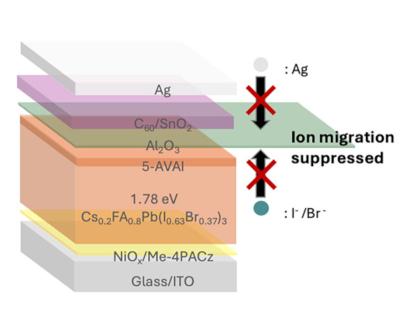Researchers from Northwestern University, Arizona State University, University of Toronto and National University of Singapore have addressed the issue of ion migration, which deteriorates the performance and stability of perovskite solar cells (PSCs). The team has developed a new method to improve the stability and efficiency of PSCs through surface functionalization, which uses a chemical compound called 5-ammonium valeric acid iodide (5-AVAI) to enable the uniform growth of aluminum oxide (Al₂O₃) through atomic layer deposition. This process creates a robust barrier that suppresses halide migration by more than an order of magnitude.
Using this method, the researchers tested solar cells, and found that they retained 90% of their initial power conversion efficiency (PCE) after 1,000 hours of continuous operation at 55 degrees Celsius under full sunlight, compared to less than 200 hours without the barrier layer.
“We are diligently working on perovskite solar cells because they have the potential to achieve higher solar power conversion efficiency compared to existing market technologies, especially when coupled with traditional silicon panels to enhance silicon’s efficiency to significantly reduce the cost of solar electricity,” said Northwestern University's Bin Chen, the study’s lead author. “However, the commercialization of perovskite devices has been limited by issues like halide migration, which affects their stability and lifespan. Our innovation provides a solution to this challenge by enhancing the reliability of perovskite solar cells. By overcoming these technical barriers, we are opening the door to a new generation of high-efficiency, reliable solar cells that can accelerate the adoption of renewable energy globally.”
Atomic layer deposition, the technique used to deposit the protective aluminum oxide layer, is already a well-established industrial process in silicon-based electronics. This compatibility could make it easier for manufacturers to adopt the new method at scale, bridging the gap between high-performance lab prototypes and commercial solar panels.
“The ability to deposit metal oxides directly on the sensitive perovskite surface without causing damage opens pathways to the development of inverted PSCs that use inorganic electron transport layers. This advancement could pave the way for longer-lasting perovskite solar cells,” said Deokjae Choi, the paper’s first author. Choi emphasized that this work is a step toward unlocking the full potential of PSCs as a viable alternative to traditional silicon panels. By improving stability without sacrificing efficiency, the study offers a path forward for scaling up PSC technology.
Building on this success, the researchers plan to extend their method to other types of perovskite solar cells and explore tandem architectures that combine perovskite with traditional silicon. They also aim to test alternative molecular compounds for surface treatments and validate the technology’s performance in large-area modules under real-world conditions.
“This work represents a major leap in PSC research by addressing both performance and durability,” said Donghoon Shin, the paper’s co-first author. “By combining molecular engineering with scalable industrial techniques, we’re laying the groundwork for broader advancements in renewable energy and optoelectronic systems.”




